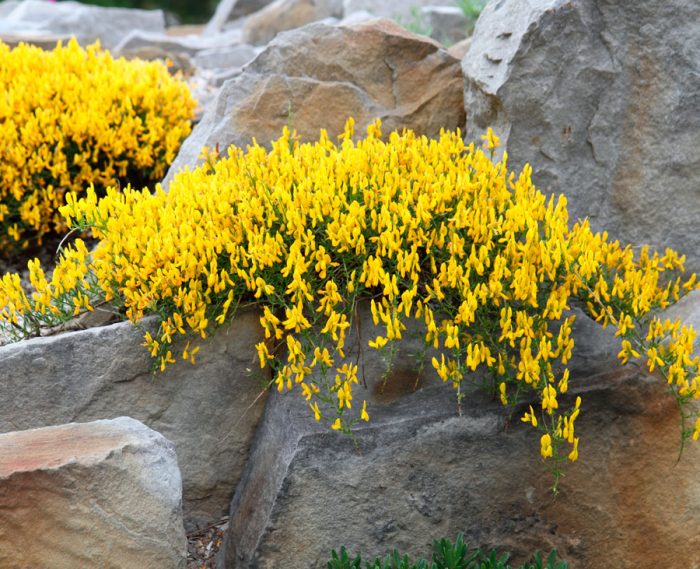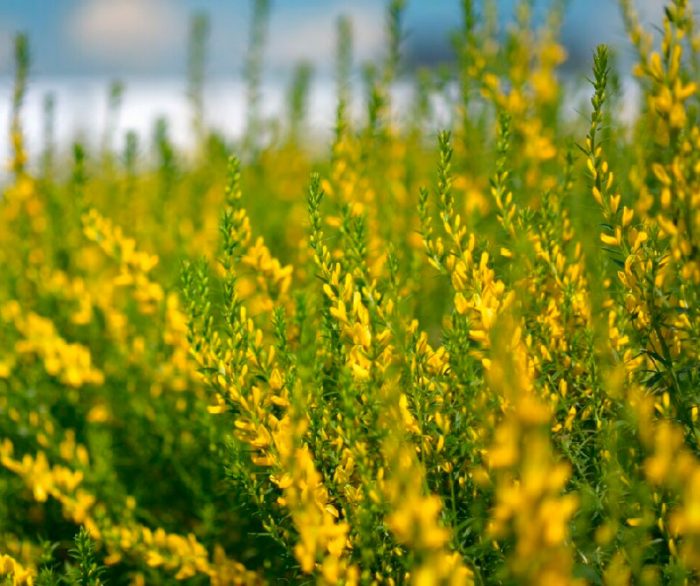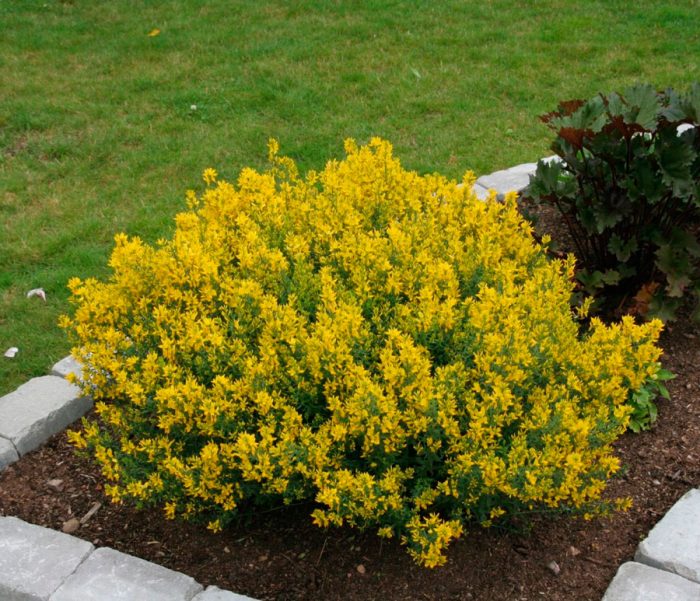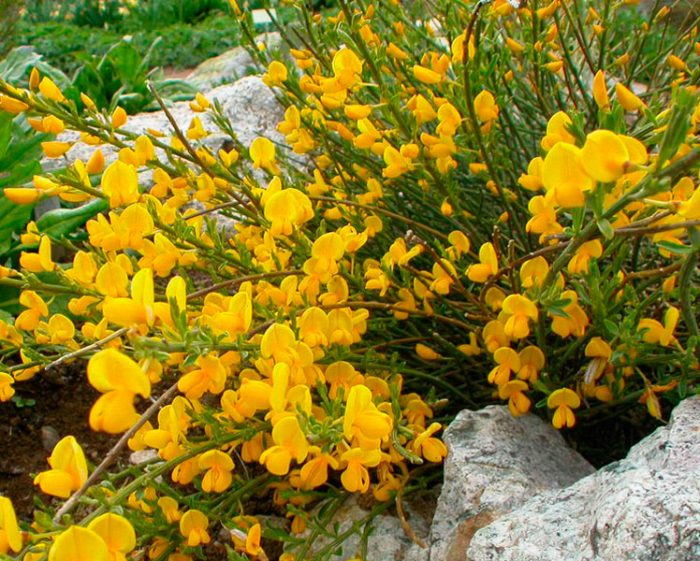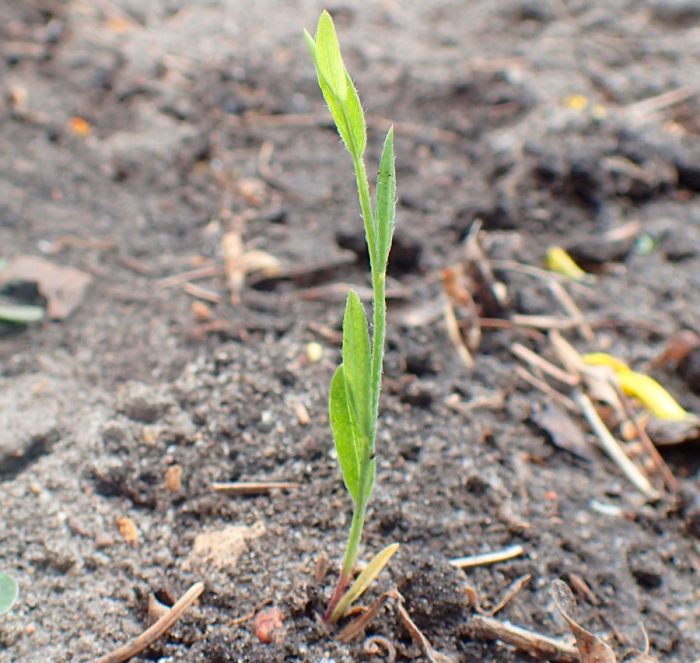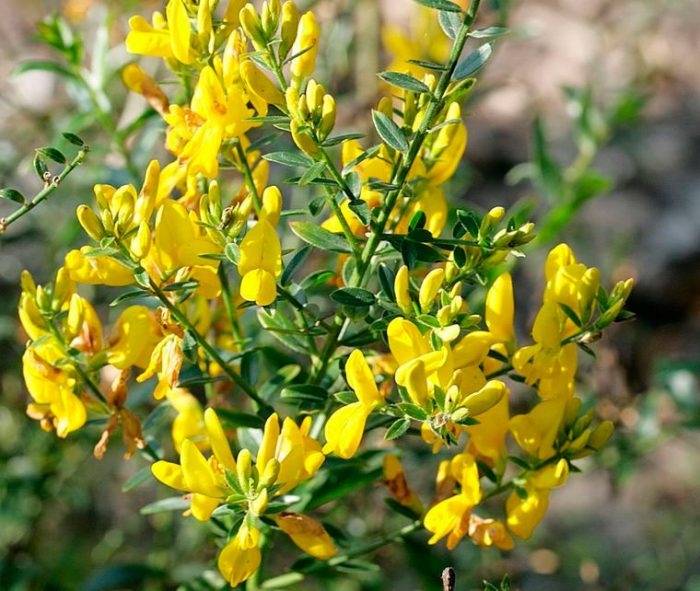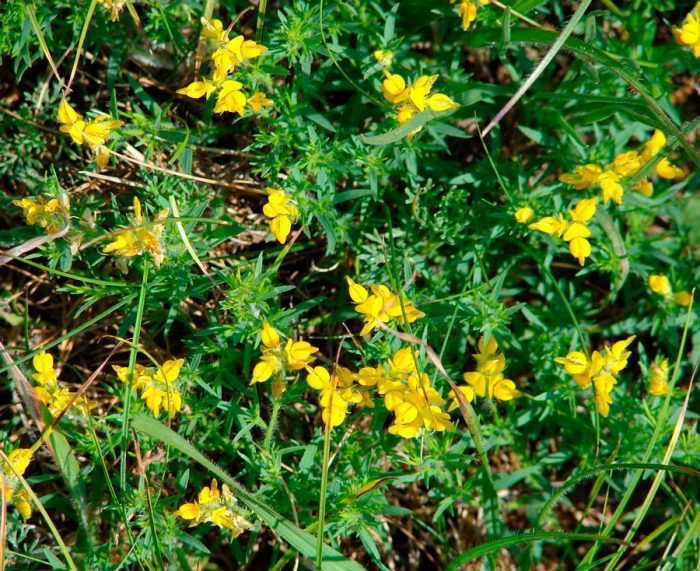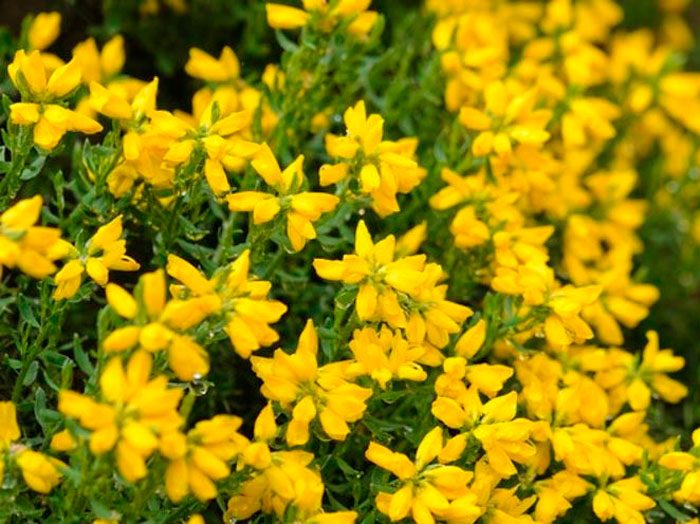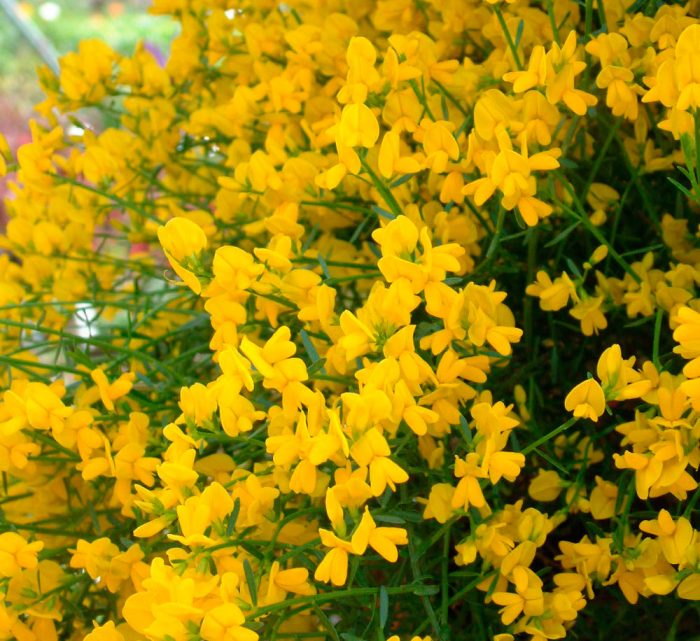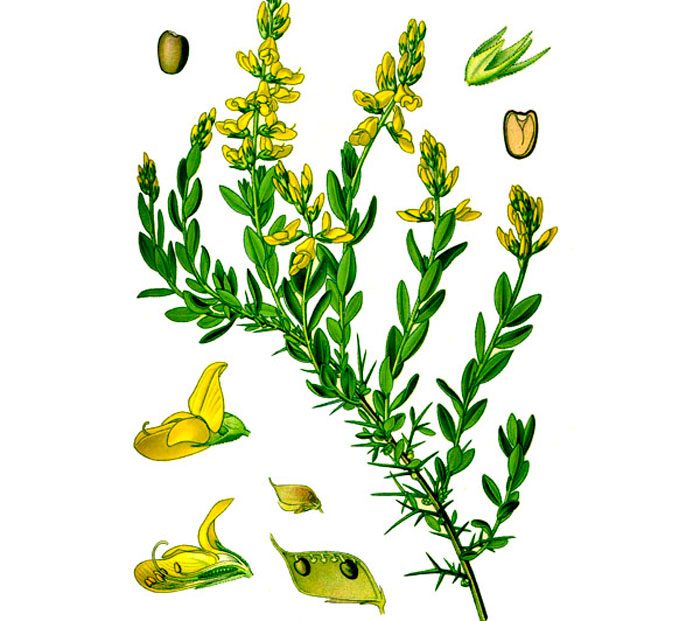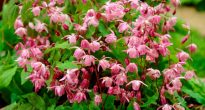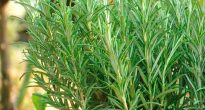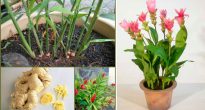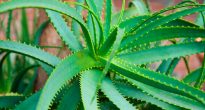A perennial plant gorse is part of the legume family, and this genus is represented by liana-like and dwarf shrubs. You can meet gorse in nature in North-West Africa and Western Europe. The plant blooms very magnificently, during this period its green dense crown is decorated with many flowers of a golden hue.
Gorse is distinguished by its photophilousness, therefore, it is most often used to decorate the slopes, and it is also often grown around the perimeter of the lawn. The gorse makes the garden look sleeker and brighter. In addition, it has healing properties and is used in folk medicine.
Content
Description of gorse
The genus gorse is represented by perennial dwarf shrubs, shrubs and woody lianas. Its stems are both thorny and smooth. The surface of dense thin branches is covered with a smooth bark of a rich green color. In height, the bush can reach from 0.3 to 1.7 meters. Depending on the type, the shoots can be creeping or erect. Stems cover lateral processes along their entire length. The branches are decorated with lush petiolate foliage. The size of the dark green leaf plates is small, and their shape is oblong-lanceolate, and they can be simple or trifoliate. The foliage surface can be smooth or covered with a short nap.
The first flowering of such a plant is observed at the age of three to six years. In the first days of summer, many brushes of a rich yellow color appear on the bush. They do not fly from the branches for 15-60 days. Axillary flowers are grouped at the tops of young branches. The bloom is so lush that the gorse foliage cannot be seen because of the flowers. After flowering, fruits appear that ripen in August. The fruits are narrow, long and glossy elongated beans, inside which are black-brown seeds.
Planting and caring for gorse outdoors
Taking care of the gorse growing in the garden is quite simple, since it is distinguished by its unpretentiousness. This shrub can grow and develop on its own without any involvement from the gardener.
Seat selection
A site located on a hill or slope is best suited for him.The plant develops normally on soil with a high content of limestone and sand, which has good drainage.
Transfer
If there is a need to transplant a shrub, then this can be done only until the moment it turns 3 years old. Older bushes have a highly developed root system, which will be severely injured during transplantation.
When the shrub is about 10 years old, it is recommended to replace it with a new one. The fact is that the shoots of the wasp plant stretch out strongly over time, and their exposure is also observed, which has an extremely negative effect on its decorative effect.
Lighting
Even the direct rays of the sun cannot harm this light-loving plant. It is recommended to choose an open place for planting it. If the bush grows even in a little shade, then this will lead to the rapid exposure of the shoots, while the flowering will be less lush.
Wintering
The bush can withstand heat, but severe frosts can destroy it. In mid-latitudes, in late autumn, the bushes should be covered first with a layer of spruce branches, and then with a non-woven material. If the winter in your region is not frosty and snowy, then undersized gorse species for wintering can not be covered. However, in this case, the probability of frost damage to the upper shoots is high.
Watering
This plant tolerates drought quite easily. But the stagnation of liquid in the ground can harm it. It is necessary to water the bush only during a prolonged drought.
Pruning
To form a crown, you should regularly prune the growth. At the same time, early spring is considered the best time for trimming gorse. If you want, you can give the lush thickets any shape you want. If the bush has thorns, then be extremely careful when working with it.
Reproduction methods
For reproduction of gorse, two methods are used: cuttings and seed.
Growing from seeds
Seeds are harvested in August, as soon as they ripen. After ripening, the fruit turns brown, and cracks appear on it. Seed material should be slightly dried, after which it is immediately sown in open soil, and it should be buried 25–30 mm. Sprinkle the seeds with a layer of soil and sprinkle with a little water. Seedlings grown from seeds will bloom for the first time not earlier than in the third year of growth.
Cuttings
Some species of gorse can be propagated by cuttings. The harvesting of apical cuttings is carried out in June, and their length can vary from 12 to 15 centimeters. Immediately after cutting, they are planted in a moistened substrate of peat and sand, and they do not need preliminary preparation. At the time of rooting, the cuttings are covered with a transparent cap on top, or they are transferred to the greenhouse. Note that on average only 3-4 out of 10 cuttings take root.
Types of gorse with photos and names
The gorse genus comprises 125 different species. Some of these species are suitable for cultivation in mid-latitudes.
Dyeing gorse (Genista tinctoria)
This flower can be found in Kazakhstan, Western Siberia, and the Middle East. The height of such a spreading undersized shrub is only about 100 cm. The creeping stems are weakly branched and they have no thorns at all. The almost bare leaf plates are narrow, oblong and dark green in color. In length, they reach no more than 25 mm. In the upper parts of young shoots, brushes are formed, consisting of yellow flowers. The bush blooms in June, and the flowering duration is about two months (up to 65 days). If the flowers are pollinated, narrow, flattened beans are formed in their place. Not so long ago, yellow paint was extracted from foliage and flowers, which influenced the formation of the name.
German gorse (Genista germanica)
This shrub loves warmth, and frost can destroy it. The bush can reach about 120 cm in diameter, and up to 60 cm in height. On the surface of upright branches there is pubescence, as well as sessile lanceolate leaf plates.On the seamy side of the foliage there is a felt pubescence. In the place where the leaf plate is attached to the shoot, there is a long green needle. Flowering lasts from the first days of summer until August. At this time, ears of a golden hue open on the tops of the branches. Fruits ripen in October. Seed germination of this plant is very low.
Spanish gorse (Genista hispanica)
A half-meter high bush has the shape of a ball and thorns. Its dense crown includes glossy lanceolate leaf plates of a rich green color, which reach about 10 mm in length. The bush blooms in two stages. During the first flowering, which occurs in early summer, lush inflorescences of a rich yellow color are formed. The bush blooms again in the last days of August, while it is less splendid. This plant is not afraid of frosts down to minus 20 degrees.
Lydian gorse (Genista lydia)
In nature, this species is found in southern Europe, despite the fact that it is not harmed by frosts down to minus 15 degrees. The creeping stems are located at the very surface of the soil, and they can also effectively fall from the slopes of the mountains. The shoots are covered with dense oval small foliage of a dark green color. Lush bloom is observed from April to June.
Useful properties of gorse
In gorse, the shoots, flowers and roots contain alkaloids, essential oils, tannins, and flavonoids. In traditional medicine, gorse is not used because it is poorly understood. But in most countries it is widely used in alternative medicine, preparing tinctures and decoctions on its basis. These funds have a tonic, sedative, diuretic and laxative effect. They remove all toxins from the body, and also contribute to the rapid healing of wounds and the destruction of skin infections. These funds are used in the treatment of rheumatism, malaria, tonsillitis, hepatitis, allergic dermatitis, stomatitis and bronchial asthma. In order to remove papillomas or warts, fresh gorse juice is used.
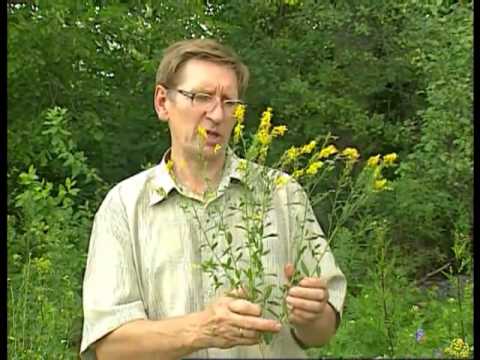

Watch this video on YouTube
Contraindications
The composition of this plant contains toxic substances, in this regard, improper use of funds can lead to sad consequences. They are categorically contraindicated for women during pregnancy and breastfeeding, as well as for hypertensive patients and children.
Gorse in landscape design
Gardeners especially appreciate gorse for their lush and spectacular bloom. It looks great in solo landing, and you can land it both near the fence and at the entrance to the house. Low as well as creeping species can be used to decorate hills and rocky slopes of southeast and south orientation. Also, the shrub is suitable for strengthening crumbling soil.
Gorse is often used for planting in rockeries, rock gardens, and somewhat less often in mixborders. The bush looks best next to tree and shrub crops, for example: with cotoneaster, yew, elecampane, juniper, euonymus, barberry or buzulnik.

